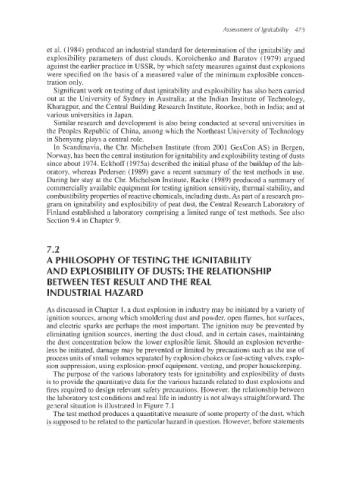Page 508 - Dust Explosions in the Process Industries
P. 508
Assessment of lgnitability 475
et al. (1984) prciduced an industrial standard for determination of the ignitability and
explosibility parameters of dust clouds. Korolchenko and Baratov (1979) argued
against the earlier practice in USSR, by which safety measures against dust explosions
were specified on the basis of a measured value of the minimum explosible concen-
tration only.
Significant work on testing of dust ignitability and explosibility has also been carried
out at the University of Sydney in Australia; at the Indian Institute of Technology,
Kharagpur, and the Central Building Research Institute, Roorkee, both in India; and at
various universities in Japan.
Similar research and development is also being conducted at several universities in
the Peoples Republic of China, among which the Northeast University of Technology
in Shenyang plays a central role.
In Scandinavia, the Chr. Michelsen Institute (from 2001 GexCon AS) in Bergen,
Norway, has been the central institution for ignitability and explosibility testing of dusts
since about 1974. Eckhoff (1975a) described the initial phase of the buildup of the lab-
oratory, whereas Pedersen (1989) gave a recent summary of the test methods in use.
During her stay at the Chr. Michelsen Institute, Racke (1989) produced a summary of
commercially available equipment for testing ignition sensitivity, thermal stability, and
combustibility properties of reactive chemicals, including dusts. As part of a research pro-
gram on ignitability and explosibility of peat dust, the Central Research Laboratory of
Finland established a laboratory comprising a limited range of test methods. See also
Section 9.4 in Chapter 9.
HILOSOPHY OF TESTING THE IGNlTABlLlTY
AND EXPLOSIBILITY OF DUSTS: THE RELATIONSHIP
TWEEN TEST RESULT AND THE REAL
NDUSTRIAL HAZARD
As discussed in Chapter 1, a dust explosion in industry may be initiated by a variety of
ignition sources, among which smoldering dust and powder, open flames, hot surfaces,
and electric sparks are perhaps the most important. The ignition may be prevented by
eliminating ignition sources, inerting the dust cloud, and in certain cases, maintaining
the dust concentration below the lower explosible limit. Should an explosion neverthe-
less be initiated, damage may be prevented or limited by precautions such as the use of
process units of small volumes separatedby explosion chokes or fast-acting valves, explo-
sion suppression, using explosion-proof equipment, venting, and proper housekeeping.
The purpose OS the various laboratory tests for ignitability and explosibility of dusts
is to provide the quantitative data for the various hazards related to dust explosions and
fires required to design relevant safety precautions. However, the relationship between
the laboratory test conditions and real life in industry is not always straightforward. The
general situation is illustrated in Figure 7.1
The test method produces a quantitative measure of some property of the dust, which
is supposed to be related to the particular hazard in question. However, before statements

